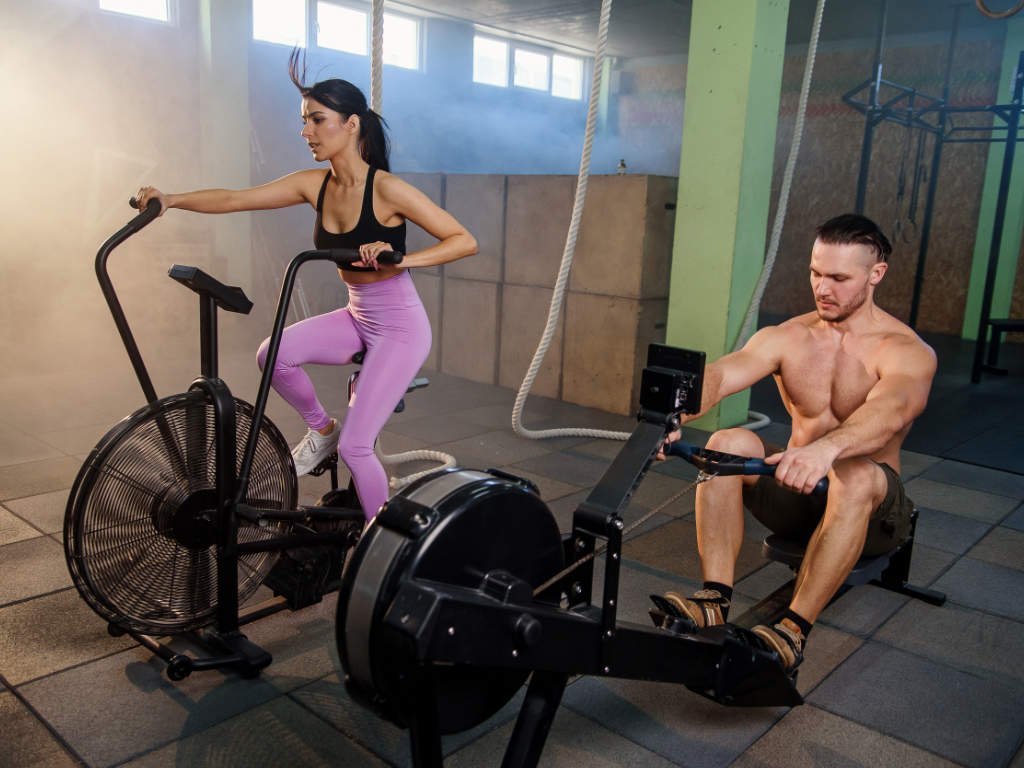Have you ever wondered why some people seem to have endless energy while others struggle to climb a flight of stairs? The secret often lies in one powerful word: cardio exercises. Whether you’re just starting your fitness journey or looking to break through a plateau, cardiovascular training holds the key to unlocking your body’s potential and transforming your health from the inside out.
Think about it—your heart is the engine that drives everything you do. From powering through a busy workday to playing with your kids, every moment depends on your cardiovascular fitness. Yet so many of us neglect this crucial aspect of our health until we’re gasping for breath or feeling sluggish throughout the day.
Here’s the exciting truth: incorporating effective cardio exercises into your routine doesn’t just improve your physical appearance—it literally rewires your body for success. We’re talking about better sleep, sharper mental focus, increased confidence, and the kind of vitality that makes you feel unstoppable. Ready to discover the five powerhouse cardio exercises that can revolutionize your fitness game? Let’s dive in.
What Are Cardio Exercises and Why Should You Care?
Cardio exercises, also known as aerobic exercises or cardiovascular training, are activities designed to get your heart pumping and keep your body moving continuously. But here’s what makes them truly special—they’re not just about breaking a sweat. These exercises strengthen your heart muscle, improve lung capacity, and enhance your body’s ability to deliver oxygen to working muscles.
The beauty of cardio lies in its versatility. You might be jogging through your neighborhood, dancing in your living room, swimming laps at the local pool, or cycling through scenic trails. What matters is that you’re sustaining movement that elevates your heart rate for an extended period.
According to the American Heart Association, adults should aim for at least 150 minutes of moderate-intensity aerobic activity per week. That breaks down to just 30 minutes, five days a week—totally achievable when you find activities you genuinely enjoy.
But let’s talk about what cardio actually does for your body. When you engage in regular cardiovascular exercise, you’re essentially giving your circulatory system a workout. Your heart becomes more efficient at pumping blood, your lungs get better at processing oxygen, and your muscles develop the ability to use that oxygen more effectively. It’s like upgrading your body’s internal engine for peak performance.
The Life-Changing Benefits of Cardiovascular Training
Here’s where things get really exciting. The benefits of cardio exercises extend far beyond what you might expect. Sure, you’ll burn calories and potentially lose weight, but that’s just scratching the surface.
Mental Health Transformation: Regular cardio triggers the release of endorphins—those feel-good chemicals that naturally boost your mood and reduce stress. Many people describe their cardio sessions as moving meditation, a time when they can clear their mind and reset their emotional state.
Energy That Lasts: This might seem counterintuitive, but spending energy through cardio actually gives you more energy. Regular aerobic exercise improves your body’s efficiency at producing and using energy, meaning you’ll feel more alert and vibrant throughout the day.
Better Sleep Quality: The Mayo Clinic notes that people who engage in regular aerobic exercise often experience deeper, more restorative sleep. Your body uses this recovery time to repair and strengthen itself, creating a positive cycle of health improvements.
Disease Prevention: Perhaps most importantly, consistent cardio exercise significantly reduces your risk of heart disease, stroke, diabetes, and certain types of cancer. It’s like taking out an insurance policy on your future health.
Understanding Heart Rate Zones: Your Personal Fitness GPS
![]()
One of the most game-changing concepts in cardio training is understanding heart rate zones. Think of these zones as your personal GPS for fitness—they tell you exactly where you are and help you navigate toward your goals.
Your heart rate zones are calculated based on your maximum heart rate, which you can estimate by subtracting your age from 220. Here’s how the zones typically break down:
Zone 1 (50-60% max HR): This is your recovery zone, perfect for warm-ups, cool-downs, or active recovery days. You should be able to have a full conversation while exercising in this zone.
Zone 2 (60-70% max HR): Often called the “fat-burning zone,” this is where your body primarily uses fat for fuel. It’s ideal for longer, steady-state cardio sessions.
Zone 3 (70-80% max HR): This aerobic zone improves your cardiovascular efficiency and is where you’ll build serious endurance. Conversation becomes more challenging here.
Zone 4 (80-90% max HR): The threshold zone where you’re pushing your anaerobic limits. This is where high-intensity interval training shines.
Zone 5 (90-100% max HR): Maximum effort zone, typically sustained for very short periods during intense intervals.
Understanding these zones transforms random cardio sessions into strategic, goal-oriented workouts. Want to build endurance? Focus on zones 2 and 3. Looking to maximize calorie burn in minimal time? Zones 4 and 5 are your friends.
High-Intensity Interval Training: Maximum Results, Minimum Time
Let’s talk about the cardio method that’s revolutionizing fitness routines worldwide: High-Intensity Interval Training (HIIT). This approach combines short bursts of maximum effort with brief recovery periods, delivering incredible results in surprisingly short sessions.
Here’s what makes HIIT so powerful—it triggers what scientists call the “afterburn effect.” Your body continues burning calories at an elevated rate for hours after your workout ends. We’re talking about turning your metabolism into a 24-hour calorie-burning machine.
A typical HIIT session might look like this: 30 seconds of all-out sprinting followed by 90 seconds of walking, repeated 8-10 times. The entire workout takes less than 20 minutes, yet it can be more effective than an hour of steady-state cardio.
The versatility of HIIT is incredible. You can apply this principle to running, cycling, rowing, bodyweight exercises, or even dancing. The key is pushing yourself to that uncomfortable but manageable intensity during the work periods, then allowing your body to recover during the rest intervals.
Research shows that HIIT not only burns more calories during and after exercise but also improves cardiovascular fitness faster than traditional steady-state cardio. For busy people looking to maximize their fitness ROI, HIIT is often the perfect solution.
The 5 Powerhouse Cardio Exercises That Change Everything
Now for the main event—five cardio exercises that deliver exceptional results while being accessible to most fitness levels. Each of these can be modified to match your current abilities and progressively challenged as you get stronger.
1. Running and Jogging: The Ultimate Full-Body Cardio
Running remains the king of cardio exercises for good reason. It’s accessible, requires minimal equipment, and delivers incredible cardiovascular benefits while strengthening your entire lower body and core.
For Beginners: Start with a run-walk approach. Alternate between 1-2 minutes of jogging and 2-3 minutes of walking. Gradually increase the running intervals as your fitness improves.
For Advanced: Incorporate hill sprints, tempo runs, or long-distance challenges. Mix up your routes to keep things interesting and challenge different muscle groups.
The mental benefits of running are equally impressive. Many runners describe achieving a “runner’s high”—that euphoric feeling that comes from sustained aerobic activity. It’s your body’s natural reward system encouraging you to keep moving.
2. Swimming: Low-Impact, High-Reward Training
Swimming provides one of the most complete workouts available. It engages virtually every muscle group while being incredibly gentle on your joints. The water’s natural resistance creates strength-building benefits alongside cardiovascular improvements.
Why Swimming Rocks: Zero impact on joints, full-body engagement, and incredible calorie burn. A 155-pound person can burn over 400 calories in just 30 minutes of moderate swimming.
Getting Started: Begin with basic strokes like freestyle or backstroke for 10-15 minutes. Focus on consistent movement rather than speed. As you build confidence and endurance, add different strokes and increase duration.
Advanced Techniques: Try interval training in the pool—sprint one lap, then swim two laps at a moderate pace. The built-in recovery periods make this extremely effective for building both speed and endurance.
3. Cycling: Power, Endurance, and Pure Fun

Whether you prefer outdoor adventures or indoor cycling classes, this cardio exercise builds incredible leg strength while providing an outstanding cardiovascular workout. Cycling allows you to control intensity easily, making it perfect for both beginners and advanced athletes.
Outdoor Cycling: Explore new areas, enjoy nature, and turn your workout into an adventure. Hill climbing naturally provides interval training, while flat terrain allows for sustained aerobic work.
Indoor Options: Stationary bikes, spin classes, or interactive platforms like Peloton offer weather-independent training with structured workouts and motivating instruction.
The Calorie Connection: Moderate cycling burns approximately 300-400 calories per hour, while vigorous cycling can burn 600+ calories. It’s an excellent choice for sustainable weight management.
4. Rowing: The Ultimate Full-Body Power Move
Rowing might be the most underrated cardio exercise available. It simultaneously works your legs, core, back, and arms while providing intense cardiovascular benefits. The rowing motion also promotes better posture—a welcome benefit for anyone spending hours at a desk.
Proper Form is Key: The rowing stroke consists of four parts: catch (starting position), drive (power phase), finish (end position), and recovery (return). Mastering this sequence maximizes effectiveness while preventing injury.
Why Rowers Love It: Low impact, high calorie burn (400-600+ calories per hour), and incredible strength development. Rowing also provides a meditative rhythm that many find mentally relaxing.
Getting Started: Begin with 10-15 minute sessions focusing on form over speed. Gradually increase duration and add interval training as your technique improves.
5. Jump Rope: Childhood Fun Meets Serious Fitness
Don’t underestimate this playground classic. Jump rope delivers one of the most efficient cardio exercises available, burning more calories per minute than most other activities while improving coordination, balance, and agility.
Calorie Crushing Power: A 155-pound person burns approximately 450 calories in 30 minutes of moderate jump rope. That’s more than running at a 6-minute-per-mile pace!
Progression Path: Start with basic two-foot jumps for 30-60 seconds, followed by rest periods. As you improve, try alternating feet, double-unders, or crisscross patterns.
Space-Efficient: Need just 6 feet of ceiling height and 4 feet of floor space. Perfect for home workouts, travel, or small apartments.
Maximizing Your Cardio Results: Smart Strategies That Work
Getting the most from your cardio exercises isn’t just about working harder—it’s about working smarter. Here are proven strategies to amplify your results while making your workouts more enjoyable and sustainable.
Progressive Overload: Gradually increase duration, intensity, or frequency. Your body adapts to challenges, so consistent progression prevents plateaus and ensures continued improvement.
Variety is Victory: Rotating between different cardio exercises prevents boredom while challenging your body in new ways. Try combining 2-3 different activities each week.
Fuel Your Performance: Proper nutrition supports your cardio efforts. Consider reading our guide on balanced diet guidelines to optimize your energy levels and recovery.
Recovery Matters: Rest days aren’t lazy days—they’re when your body actually gets stronger. Incorporate active recovery like gentle walking or stretching, and prioritize sleep for optimal results.
Track Your Progress: Whether using a fitness app, heart rate monitor, or simple journal, tracking helps you see improvements and stay motivated during challenging periods.
The Perfect Cardio Schedule: Making It Work for Real Life
Creating a sustainable cardio exercise routine requires balancing effectiveness with practicality. Here’s a realistic approach that delivers results without overwhelming your schedule:
The Weekly Blueprint: Aim for 3-5 cardio sessions per week, varying intensity and duration. Mix 2-3 moderate-intensity sessions (30-45 minutes) with 1-2 high-intensity sessions (15-25 minutes).
Monday Motivation: Start your week with a moderate-intensity session like jogging or cycling. This sets a positive tone and provides energy for the days ahead.
Wednesday Power: Mid-week HIIT session to maintain momentum. Try 20 minutes of interval training using any of our five powerhouse exercises.
Weekend Warriors: Use longer sessions for stress relief and exploration. This might be a scenic bike ride, swimming session, or hiking adventure.
Listen to Your Body: Some days you’ll feel unstoppable, others you might need gentle movement. Adjust intensity based on how you feel, not just what your schedule says.
Combining Cardio with Strength Training: The Ultimate Fitness Formula

While cardio exercises provide incredible benefits, combining them with strength training creates the ultimate fitness approach. This combination maximizes calorie burning, builds lean muscle mass, and creates a balanced, functional body.
The Synergy Effect: Strength training builds muscle, which increases your resting metabolic rate. More muscle means you burn more calories even when you’re not exercising. Meanwhile, cardio improves your recovery between strength sets and enhances overall endurance.
Smart Scheduling: Try alternating cardio and strength days, or combine them in single sessions. You might do 20 minutes of cardio followed by 20-30 minutes of strength training, or vice versa.
Consider exploring our comprehensive strength training guide to learn how to integrate these approaches effectively.
Common Cardio Mistakes to Avoid
Even well-intentioned fitness enthusiasts can undermine their progress with these common mistakes. Avoiding these pitfalls will accelerate your results and keep you injury-free.
Mistake #1: Going All-Out Every Time: Your body needs variety in intensity. Constantly pushing maximum effort leads to burnout and increases injury risk.
Mistake #2: Ignoring Form for Speed: Whether running, rowing, or cycling, proper form prevents injury and maximizes effectiveness. Slow down if you can’t maintain good technique.
Mistake #3: Neglecting Recovery: Your body adapts and grows stronger during rest periods, not during the actual workout. Skipping recovery days often leads to plateaus or setbacks.
Mistake #4: Comparing Yourself to Others: Everyone’s fitness journey is unique. Focus on your personal progress rather than trying to match someone else’s performance.
Creating Motivation That Lasts
The most effective cardio exercises are the ones you’ll actually do consistently. Building lasting motivation requires both mental and practical strategies.
Find Your Why: Connect your cardio routine to deeper motivations. Are you training for better health, increased energy to play with your kids, or the confidence that comes from feeling strong?
Celebrate Small Wins: Acknowledge every improvement, whether it’s running an extra minute without stopping or choosing stairs over the elevator. These moments build momentum.
Make it Social: Join running groups, cycling clubs, or online fitness communities. The support and accountability of like-minded people can transform your motivation levels.
Plan for Obstacles: Life will interfere with your routine—that’s guaranteed. Have backup plans for bad weather, busy schedules, or low motivation days. Even 10 minutes of movement counts.
Frequently Asked Questions About Cardio Exercises
Q: How often should I do cardio exercises for optimal results?
A: For general health, aim for at least 150 minutes of moderate-intensity cardio per week, spread across 3-5 sessions. For weight loss or enhanced fitness, you might increase to 250+ minutes weekly. Listen to your body and gradually build up frequency.
Q: What’s better for fat loss: long, steady cardio or short, intense intervals?
A: Both approaches work, but HIIT often provides superior results in less time due to the afterburn effect. However, longer steady-state sessions are better for building aerobic base and can be more sustainable for beginners. The best approach combines both methods.
Q: Can I do cardio every day without overtraining?
A: Yes, but vary intensity and duration. You might do high-intensity work 2-3 times per week with moderate or low-intensity activities on other days. Active recovery days with gentle walking or yoga help maintain consistency without overwhelming your system.
Q: How do I know if I’m working at the right intensity?
A: Use the “talk test”: during moderate intensity, you should be able to speak in short sentences but not hold a full conversation. During high intensity, speaking becomes very difficult. Heart rate monitors provide more precise feedback if you prefer data-driven approaches.
Q: What should I eat before and after cardio workouts?
A: Pre-workout: Light snack with carbs 30-60 minutes before (banana, toast, or oatmeal). Post-workout: Combine protein and carbs within 30-60 minutes to support recovery. Hydration is crucial throughout. For detailed nutrition guidance, check our Mediterranean diet guide for heart-healthy eating patterns.
Q: How long before I see results from regular cardio exercise?
A: You’ll likely notice increased energy and improved mood within 1-2 weeks. Cardiovascular improvements typically become apparent after 4-6 weeks of consistent training. Visible physical changes often take 6-12 weeks, depending on your starting point and goals.
Your Cardio Success Story Starts Now
The journey to better health through cardio exercises isn’t just about physical transformation—it’s about reclaiming your vitality, confidence, and zest for life. Every step you take, every pedal stroke, and every lap in the pool is an investment in your future self.
Remember, you don’t need to be perfect from day one. Start where you are, use what you have available, and do what you can. Whether that’s a 10-minute walk around the block or tackling your first HIIT session, every movement matters.
The five powerhouse cardio exercises we’ve explored—running, swimming, cycling, rowing, and jump rope—provide endless variety to keep your routine fresh and challenging. Choose one that excites you, master it, then gradually incorporate others as you build confidence and fitness.
Your cardiovascular system is incredibly adaptable. With consistent effort and smart programming, you’ll be amazed at how quickly your body responds. That flight of stairs that once left you breathless? It’ll become effortless. Those energy crashes in the afternoon? They’ll be replaced by sustained vitality.
But perhaps most importantly, you’ll discover that regular cardio exercise becomes less about what you have to do and more about what you get to do. It becomes your stress relief, your thinking time, your confidence builder, and your daily dose of accomplishment.
The path to cardiovascular fitness isn’t always easy, but it’s always worth it. Your heart, mind, and future self will thank you for every single session.
For additional support on your fitness journey, explore our comprehensive resources on home workout routines and stress management techniques to create a well-rounded approach to health and wellness.
Ready to start your cardio transformation? Your journey begins with the next step—literally. Lace up those shoes, dive into that pool, or hop on that bike. Your strongest, most vibrant self is waiting.


